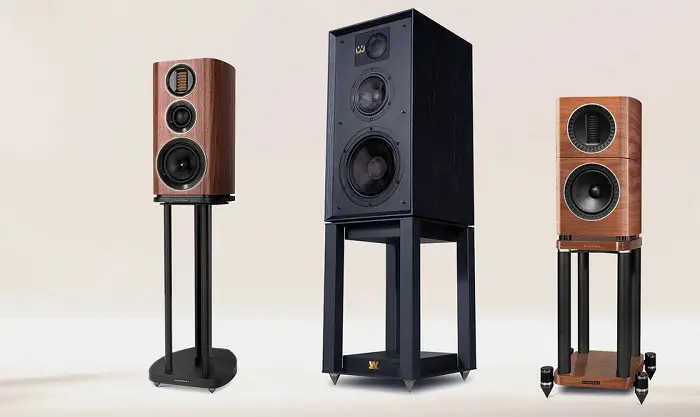When discussions go around long-standing speaker brands, Wharfedale is a name bound to be mentioned. Over 80 years and counting, the brand is not resting on its oars in terms of exceptional sound reproduction and innovative designs.
Truthfully, there’s been a lot going on in the background – collaborations, deals, and ownership transfers. Wharfedale was originally made indigenously in a part of the UK before it was sold to Verity Group and then IAG.
With that said, if you’ve ever wondered where these impressive speakers are currently made, this article would surely be of help.

Where are Wharfedale Speakers Made?
Wharfedale speakers are currently made in Ji’an, Jang Xi Province, China. They were originally manufactured wholly in Idle, a district of Bradford, West Yorkshire, England in the 1930s when they were first established.
But things sure have been evolving since the 1930s. Wharfedale is now “proudly made in China” after the brand was acquired by the International Audio Group (IAG) in 1996. It is also worth noting that the entire production process from raw to finish takes place within Ji’an.
Origin Of Wharfedale in Yorkshire, UK
Wharfedale’s history spans back to the 1930s and is deeply rooted in its Yorkshire heritage. It was founded in 1932 by Gilbert Briggs – when he built his very first loudspeaker unit in the cellar of his house. His house was located in the picturesque town of Ilkley, Yorkshire along the valley of the river “Wharfe”.
This area is known today as “Wharfedale”. Briggs named his brand after this area, and it went on to revolutionize the Hi-Fi industry.
In 1933, Briggs decided to and set up a small factory near Bradford to build units of his loudspeaker drive. With the demand growing exponentially, his wife, Doris Edna Briggs, spent many late nights hand winding and soldering coils for new loudspeakers.
Later that year, Wharfedale speakers participated in the annual competition organized by the Bradford Radio Society and secured both the first and second positions.
Growth and Expansion of Wharfedale
In 1936, Wharfedale had grown bigger than its small factory, so Gilbert Briggs moved to a larger factory, also located in Bradford. And in the early 1940s, during the latter half of the world war, Wharfedale became a team of 20 staff, and successfully manufactured 40, 000 units in that period.
In 1945, Gilbert’s Wharfedale built one of the world’s first two-way loudspeakers, which had two drivers in it; the woofer and the tweeter. The speaker was quite oversized and heavy, but it was the design that inspired the development of the modern-day loudspeaker. Gilbert Briggs didn’t stop there, he went on to publish his first book titled, ‘Loudspeakers: The Why and How of Good Reproduction’.
The 1950s saw Gilbert in collaboration with Quad’s Peter Walker who was an intimate colleague. Together, they went on a series of concerts in the UK and the USA, inviting audiences to personally witness the contrast between live and recorded music.
Wharfedale was Sold Out
In 1958, Wharfedale was sold to Rank Organisation – a British entertainment conglomerate. A move that was disputed at the time, but ended up expanding the Wharfedale brand into trending areas such as electronics.
During the 1960s, the company ventured into electronics production, introducing several tuners, amplifiers, and even turntables to the market. Wharfedale became a representation of not only quality but also style, as this was what mattered to their new youthful market.
All this while, Gilbert Briggs was still managing the daily running of the company – it was not until 1965 that he retired.
As expected, in the 1970s, demand for Hi-Fi products shifted more and more to those built with style and fashion. The material used played a huge role – cutting-edge synthetic materials and Vinyls were introduced. And since Wharfedale products were meeting up, the brand grew at a very fast pace, so much so that their manufacturing was moved to a more efficient factory on a field site in Highfield Road, Bradford.
The factory’s construction took about 7 years. When it was finished, it boasted of extensive research and development centers.
Rank Organisation later sold out Wharfedale to a large group of companies called ‘Verity Group PLC’. Verity Group also owned the famous Quad and Leak Audio.
Is Wharfedale Made in China?
Yes, Wharfedale is made in China. On September 19, 1997 – Wharfedale was acquired by the International Audio Group (IAG) after striking a deal with Verity Group.
The IAG’s subsidiaries are mainly hi-fi brands including Wharfedale, Quad, Leak, Audiolab, Mission, Luxman, and Castle, also, featuring extra professional audio and lighting labels like COEF, F.A.L, and Quad Industrial too.
Their recently established production facility is located in Jian, Jiangxi Province. It spans around 400,000 sq. meters and encompasses the entire manufacturing process for speakers and electronics, from raw materials to final products. This IAG site in China is arguably the biggest specialized audio manufacturing facility globally, all situated in one location.
With its headquarters and manufacturing facilities in Asia (China and Japan). They also have offices in North America; and in Huntingdon, Cambridgeshire, UK.
Wrap-up
From its modest beginnings in the heart of Yorkshire to its international presence today, Wharfedale has continued to maintain a steadfast commitment to the Hi-Fi world of quality and design. Their Diamond series is a testament to this; highlighted by WhatHifi as “one of the most successful speaker ranges of all time”.






![How Loud is a 1000-Watt Speaker? [Analysis] How Loud is a 1000-Watt Speaker? [Analysis]](https://audiojust.com/wp-content/uploads/2023/08/how-loud-is-a-1000-watt-speaker-211x150.jpg)


